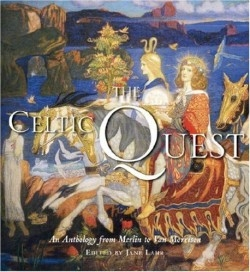The Celtic Quest
An Anthology from Merlin to Van Morrison
In her foreword, editor Jane Lahr explains her desire to recapture the imagination of the Celtic natural world through literature and art, especially as our own physical environment deteriorates.
Lahr has previously edited or co-edited similar literature and art combinations, such as Searching for Mary Magdalene: A Journey through Art and Literature and Love: A Celebration in Art and Literature.
In this beautiful anthology, every piece of literature has a corresponding image thoughtfully chosen to complement the writing. Lahr’s decision to organize the material around the Celtic lunar calendar resulted in three divisions: Song, Sword, and Star.
Each of the sections opens with a page-long summary before turning to the actual art and literature. In “Song,” for example, Lahr celebrates the Celtic bard—the poet, the storyteller, the musician. In Julius Caesar’s time bard apprenticeships lasted for years, and since Celtic literary tradition was handed down orally, all tales and poems had to be memorized.
Here, both ancient and contemporary bards are featured, including a historical Merlin, poet Dylan Thomas, and the modern-day musician Sting. One striking pairing is the anonymous twelfth-century writing The Wild Man in the Forest placed next to an eerie supernatural bronze face from the third century B.C.E. In the lunar calendar, “Song” focuses on awakening, nature, and love, as highlighted in the spring festival of Beltane.
The second section of writings and images, “Sword,” celebrates the Celtic hero who remains loyal to both his family and his warriors.
According to the editor, the melancholic tone representing pain and death in a warrior’s life also suggests a broader feeling of grief that the Celtic oral tradition has succumbed to written language and the spreading of Christianity.
Diverse literary excerpts range from a paragraph of James Joyce’s well-known Portrait of the Artist as a Young Man to an obscure selection from the anonymous twelfth-century Cattle Raid of Cooley.
The corresponding art varies greatly as well. A nineteenth-century watercolor by Sir Frederick William Burton called The Meeting on the Turret Stairs depicts a classic hero attired in full combat gear clinging to the arm of his lover. And a fourteenth-century illustrated manuscript from L’Estoire de Merlin shows King Arthur in battle. Progressing in the Celtic lunar calendar, “Sword” concentrates on loss, battles, maturity, and centers around the summer harvest celebration of Lughnasadh.
Finally, in the third section, “Star,” the editor honors druids—the Celtic priestly class who served as philosophers, advisers, and links to the supernatural. Celtic pantheists believed in the immortality of the soul, reincarnation, and the possibility of shape-shifting into animals and other humans. These views are illustrated by Robert Graves’ brief four-line poem “Serpent’s Tail,” which is partnered with a Gaelic Scottish prayer and a detail of an ancient silver cauldron depicting a Celtic shaman holding a snake. One of the longest excerpts in the book is found in this section, George MacDonald’s “The Day Boy and the Night Girl,” a tale opening with a cruel witch hungry to know everything. “Star” completes the end of the pastoral year with the season of Samhain. The gorgeous paintings, drawings, metalwork, and photos that grace the pages of Celtic Quest will draw in readers immediately.
As beautiful a book as this is, however, some readers might be distracted by the lack of consistent citations in both the literature and the art. For example, while the art titles are generally notated carefully, artists who are presently alive are described merely as “living artists” without supplying at least a birth date.
The literary citations could be more complete as well. Many of the selections simply state the author’s name and his or her country of origin, such as “Kathleen Raine, Scottish,” without providing pertinent information about birth and death, as well as when the writing occurred. More consistent and informative citation throughout the book would enhance its flow, allowing readers to better enjoy the fabulous material without being sidetracked about the lack of dates.
The content of Celtic Quest is indeed marvelous; a delight for the scholar and novice both. Swung back in time by the outstandingly presented images, readers will feel the power, magic, and inspiration of the ancient art of storytelling.
Reviewed by
Beth Hemke Shapiro
Disclosure: This article is not an endorsement, but a review. The publisher of this book provided free copies of the book to have their book reviewed by a professional reviewer. No fee was paid by the publisher for this review. Foreword Reviews only recommends books that we love. Foreword Magazine, Inc. is disclosing this in accordance with the Federal Trade Commission’s 16 CFR, Part 255.

